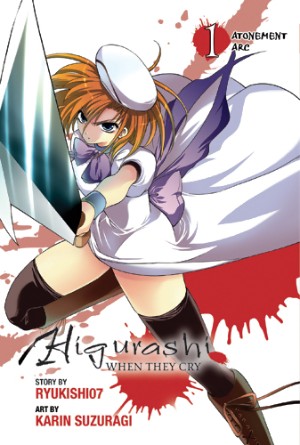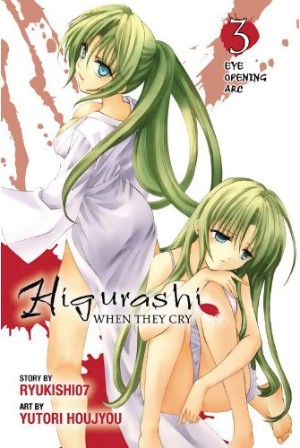Story by Ryukishi07; Art by Karin Suzuragi. Released in Japan as “Higurashi no Naku Koro ni: Tsumihoroboshi-hen” by Square Enix, serialized in the magazine Gangan Powered. Released in North America by Yen Press.
It’s Halloween, and time for all good bloggers to discuss horror. And so I will talk about Higurashi, which may be a mystery series, and may also be a harem series, but is first and foremost known for its graphic horror. This volume starts a new arc, with events once again reset to the middle of June. There’s a basic horror in the premise: the cast are dying in horrible ways over and over, each time with someone falling into a spiral of paranoia and insanity. Worst of all, the young priestess Rika seems to be aware of the previous iterations. Will this arc, focusing on the cute redhead Rena, be any more optimistic?
Well, probably, but not in this first volume. This is the start of the “Atonement” arc, which is the mirror of the first arc of the entire series, the ‘Abducted by Demons’ arc. Unlike the previous Shion arc, however, which told the same events but from a new perspective, this is showing an entirely different plot, focusing on Rena. We do start off bright and happy as always, with Rena and the rest of the club playing a penalty game with water guns in gym class. As the story goes on, though, we realize that the chapter title “Happy Rena” is misleading, and that she uses a smile to mask her inner pain and sadness. And what’s more, it’s getting obvious.
Rena is an interesting case. Most of the previous arcs have shown the protagonist (Keiichi at first, then Shion) start off relatively well-adjusted, then slowly the paranoia and madness seeps into them as they start imagining things that aren’t really happening. Rena’s backstory shows us that she’s already been committed for a long period after her parent’s divorce, and has attempted suicide as well as assault. And while moving back to Hinamizawa helped briefly, now that a new woman is cozying up to her father, the old feelings are starting up again.
In addition to Rena not really needing much impetus to get her started into killing other people, the people she’s dealing with are those that we’re not really going to miss. It turns out that her father’s new love is a gold digger who leeches onto men and gradually strips them of their money… something she casually brags about in a cafe while on the arm of Satoko’s uncle. Remember him? Back in the Curse Killing arc, we saw his physical and mental abuse of the fragile Satoko. Combined with his new love, they’re a couple that Rena is allowed to kill while still retaining the audience’s sympathy… or are they? Does anything justify murder?
As for the horror elements in this volume, for those who were creeped out by the fingernail torture in the Eye Opening Arc, well, we may have found a way to top it. Rena’s repressed rage and despair apparently comes into her head in the form of imaginary maggots that are inside her skin. Note they don’t feel imaginary to her – or to us, as we see them a few times, most notably bursting from her neck as she tries to kill herself in a flashback. Karin Suzuragi’s art is generally considered the “cutest” and most “moe” of the group of artists adapting the series, so this is particularly grotesque. There’s also Rena’s murder of Rina, the aforementioned gold-digger. The anime keeps things vague and silhouetted, but the manga has no trouble being graphic, showing Rina being beaten to death with a pipe (after trying to strangle Rena, to be fair) and begging for her life once she realizes what Rena will do. Oh yes, and eyeballs bulging from sockets, a Higurashi classic.
Higurashi makes for an excellent horror series, but it’s the mystery and characters that keep me coming back after so many deaths and resets. This isn’t the final arc, so I know things will turn south – they already have. But I want to know if the heroes can get any closer to redeeming Rena, and if she can find the “atonement” the arc title implies. I also want to know why this reset keeps happening. There’s got to be more to it than just torturing teenagers over and over again. Gripping, unnerving, and with a jarring contrast between art and events. Welcome to Hinamizawa.



